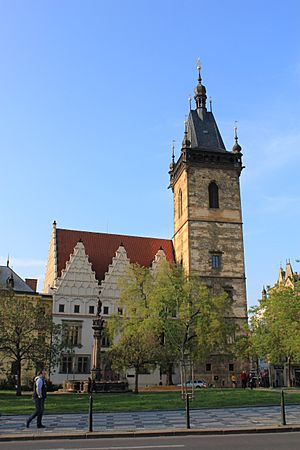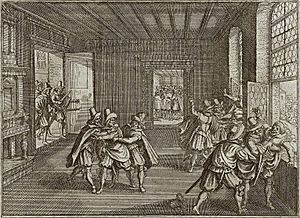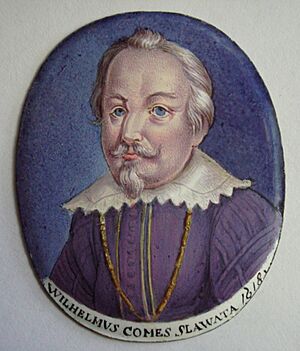Defenestrations of Prague facts for kids
The Defenestrations of Prague were three important events in the history of Bohemia (which is now part of the Czech Republic). During these events, people were defenestrated. This means they were thrown out of a window.
The word "defenestrate" comes from Latin and means "out of the window." It became well-known because of these events in Prague. The most famous defenestration happened in 1618. During this event, unhappy Protestant leaders threw two royal governors and their secretary out of a window at Hradčany Castle.
In the Middle Ages and early modern times, throwing people out of windows was sometimes used as a form of mob justice. It was a way for groups of people to show their anger.
The first major defenestration happened in 1419. The second was in 1483, and the third in 1618. The term "Defenestration of Prague" usually refers to the third one. However, sometimes the 1483 event is not seen as a "major" defenestration. This can make it confusing when the 1618 event is called the "second Prague defenestration."
The first and third defenestrations led to long religious conflicts. The first helped start the Hussite Wars. The third helped start the Thirty Years' War. The second defenestration, however, helped bring about a period of religious peace in the country for 31 years. This was called the Peace of Kutná Hora.
Contents
What Was the 1419 Defenestration of Prague?
The First Defenestration of Prague happened on July 30, 1419. A crowd of Czech Hussites killed several members of the city council.
A Hussite priest named Jan Želivský led his followers in a procession. They marched through Prague to the New Town Hall (Novoměstská radnice). The town council members had refused to release Hussite prisoners. During the march, someone threw a stone from the town hall. It supposedly hit Želivský.
This made the crowd very angry, and they stormed the town hall. Once inside, the group threw the judge, the burgomaster (a city leader), and several council members out of the window. They all died from the fall.
King Wenceslaus IV of Bohemia heard the news. He was shocked and died shortly after, possibly from the stress.
This event happened because people were very unhappy with the Church at the time. There was also a lot of unfairness between peasants, Church leaders, and nobles. These feelings, along with growing nationalism, made preachers like Jan Želivský very popular. He was influenced by John Wycliffe. Želivský believed the Catholic Church was corrupt. These preachers told their followers to take action, even to fight, against these problems.
The First Defenestration was a turning point. It moved people from just talking to taking action. This led to the long Hussite Wars, which started soon after and lasted until 1436.
What Was the 1483 Defenestration of Prague?
This defenestration took place on September 24, 1483. It happened during a time of unrest among the people of Prague. Vladislaus II of Hungary was the king of Bohemia then.
A group called the Communion under both kinds feared losing their power. They carried out a violent takeover in the Old, New, and Lesser Towns of Prague. The Old Town Burgomaster and seven New Town councilors were thrown from their town halls.
This event in Prague helped limit the king's power. It also stopped the country from going back to how things were before the Hussite movement. On October 6, 1483, the three Prague towns signed a treaty. This treaty brought the Utraquism (a Hussite group) to power. This led to religious peace and the declaration that both churches were equal at the Kutná Hora Assembly in 1485.
What Was the 1618 Defenestration of Prague?
This defenestration had a huge impact on European history. It directly led to the start of the Thirty Years' War.
Why Did the 1618 Defenestration Happen?
In 1555, the Peace of Augsburg had tried to solve religious problems in the Holy Roman Empire. It set a rule: "Cuius regio, eius religio" (meaning "whose realm, his religion"). This allowed a prince to choose the religion for his people.
Since 1526, the Kingdom of Bohemia had been ruled by Habsburg kings. These kings were Catholic, but they did not force their religion on their subjects, who were mostly Protestant. In 1609, Rudolf II, who was Emperor and King of Bohemia, gave Protestants more rights.
Rudolf II was seen as not fit to rule. Other Habsburg family members chose his younger brother, Matthias, to lead the family in 1606. Matthias slowly took control of Rudolf's lands, starting with Hungary. In 1609, to keep control of Bohemia, Rudolf issued the Letter of Majesty. This letter gave Bohemia's mostly Protestant leaders the right to practice their religion freely. It basically created a Protestant state church in Bohemia, controlled by the towns and nobles.
When Rudolf died, Matthias became the ruler of Bohemia (1612–1619). He offered more legal and religious freedoms to Bohemia. He often listened to his chancellor, Bishop Melchior Klesl.
Conflict began because of two main reasons. Matthias was old and had no children. He chose his cousin, Ferdinand of Styria, to be his heir. Ferdinand was elected king in 1617. Ferdinand was a strong supporter of the Catholic Counter-Reformation. He was not likely to be friendly to Protestantism or Bohemian freedoms.
Bohemian Protestants did not agree with the royal government. They believed the Letter of Majesty applied not only to lands owned by nobles or towns but also to the King's own lands. Matthias and Klesl were willing to meet these demands. But Ferdinand was not. In 1618, he forced the Emperor to order a stop to the building of some Protestant chapels on royal land. When the Bohemian leaders protested this order, Ferdinand had their assembly shut down.
The Defenestration of 1618
On May 23, 1618, four Catholic Lords Regent arrived at the Bohemian Chancellery. These were Count Jaroslav Bořita of Martinice, Count Vilem Slavata of Chlum, Adam II von Sternberg, and Matthew Leopold Popel Lobkowitz.
Members of the Protestant assembly, which had been shut down, gathered at 9:00 am. They were led by Count Thurn. He had lost his job as castellan (a castle governor) of Karlštejn Castle because of the Emperor. The Protestant lords wanted to know if the four regents were responsible for telling the Emperor to stop the building of Protestant churches on royal lands.
Count Martinice later wrote about the event:
Lord Paul Rziczan read aloud... a letter. In this letter, His Imperial Majesty said that all our lives and honor were already lost. This greatly scared all three Protestant groups. Since they planned to punish us, we all agreed that we would stand firm, with all for one and one for all... We would not give in. Instead, we would loyally help and protect each other against all problems. However, it is clear that this letter came from the advice of some of our religious enemies. We want to know, and we ask the lords present, if all or some of them knew about the letter, suggested it, and approved it.
Before the regents could answer, they asked for time to talk with their superior, Adam von Waldstein, who was not there. They said they would give an official answer by the next Friday. But the Protestant lords demanded an answer right away.
Two regents, Adam II von Sternberg and Matthew Leopold Popel Lobkowitz, were declared innocent by the Protestants. They were seen as too religious to be involved in the Emperor's letter. They were removed from the room. Before leaving, Adam II von Sternberg said they "did not advise anything that went against the Letter of Majesty."
This left Count Vilem Slavata of Chlum and Count Jaroslav Bořita of Martinice. They were known as strong Catholics. Also present was Philip Fabricius, the secretary to the regents. They eventually admitted they were responsible for the letter. They thought they would only be arrested and accepted any punishment.
Count von Thurn then spoke to Martinice and Slavata. He said, "You are our enemies and enemies of our religion. You wanted to take away our Letter of Majesty. You have terribly bothered your Protestant subjects... and tried to force them to accept your religion against their will or expelled them for it."
Then, to the crowd of Protestants, he continued, "If we let these men live, we would lose the Letter of Majesty and our religion... because there can be no justice from them."
Soon after, the two regents and their secretary were thrown out of a window. They fell about 70 feet from the third floor but survived. Catholics said they were saved by angels or by the Virgin Mary. Later, Protestant writers claimed they survived because they landed on a pile of manure. This story was probably made up to counter the idea of divine help. Philip Fabricius was later made a noble by the emperor. He was given the title Baron von Hohenfall, which means "Baron of Highfall."
What Happened After the 1618 Defenestration?
Right after the defenestration, the Protestant leaders and Catholic Habsburgs began gathering allies for war. After Matthias died in 1619, Ferdinand II was chosen as the Holy Roman Emperor. At the same time, the Bohemian leaders removed him as King of Bohemia. They replaced him with Frederick V, Elector Palatine. Frederick was a leading Calvinist and the son-in-law of James VI and I, King of Scotland, England and Ireland.
Because they removed a king who had been properly chosen, the Protestants could not get the international support they needed for a war. Just two years after the defenestration, Ferdinand and the Catholics regained power. This happened at the Battle of White Mountain on November 8, 1620. This battle is known as the first major battle of the Thirty Years' War.
After the battle, there was looting and destruction in Prague for weeks. Several months later, twenty-seven nobles and citizens were tortured and executed in the Old Town Square. Twelve of their heads were put on iron hooks and hung from the Bridge Tower as a warning. This event added to the anger that led to the long and terrible Thirty Years' War.
Other Defenestrations in Prague
Other times, people have been thrown from windows in Prague. However, these events are not usually called "defenestrations of Prague."
Sometimes, people use the names "the fourth" or "the third defenestration of Prague." But these names do not have a standard meaning. For example, some people have used it to describe the death of Jan Masaryk. He was found below a bathroom window of the Czechoslovak Ministry of Foreign Affairs building on March 10, 1948. His death was mysterious and widely believed to be a murder.
See also
 In Spanish: Defenestraciones de Praga para niños
In Spanish: Defenestraciones de Praga para niños






